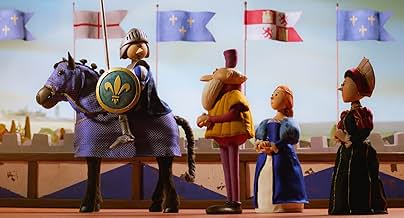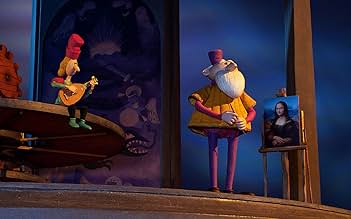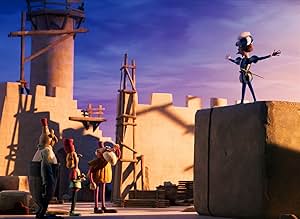Inventing flying contraptions, war machines and studying cadavers, Leonardo da Vinci tackles the meaning of life itself with the help of French princess Marguerite de Nevarre.Inventing flying contraptions, war machines and studying cadavers, Leonardo da Vinci tackles the meaning of life itself with the help of French princess Marguerite de Nevarre.Inventing flying contraptions, war machines and studying cadavers, Leonardo da Vinci tackles the meaning of life itself with the help of French princess Marguerite de Nevarre.
- Awards
- 1 win & 3 nominations
Daisy Ridley
- Marguerite
- (voice)
Matt Berry
- Pope Leo X
- (voice)
Stephen Fry
- Leonardo da Vinci
- (voice)
Aaron Heffernan
- Crowd
- (voice)
Ben Stranahan
- Page
- (voice)
Jim Capobianco
- The Physician
- (voice)
- …
Pierre-Luc Granjon
- Pierre-Luc
- (voice)
Jane Osborn
- Gravedigger Jane
- (voice)
Chris Gordon
- Crowd
- (voice)
Janan Abir
- Crowd
- (voice)
T.M. Christopher
- Swiss Guards
- (voice)
Teemu Oksanen
- Crowd
- (voice)
- Directors
- Writer
- All cast & crew
- Production, box office & more at IMDbPro
Storyline
Did you know
- TriviaMarion Cotillard voiced Louise of Savoy in both the English and the French version of the film.
- GoofsMichaelangelo is shown painting the ceiling of the Sistine Chapel under the patronage of Pope Leo X.
Michaelangelo was actually commissioned by the previous Pope, Julius II, and had completed the work a year before Leo X was elected.
Featured review
A delight, especially for those who enjoy history. This multi-style animated feature tells the story of Leonardo DaVinci's later life.
Spurning trendy 3D-driven computer animation with its dense content and over-caffeinated dialog, this film takes its time, spreads out, and dives deeply and gracefully into "The Maestro's" Italy and France that he inhabits. The primary animation style is 3D stop motion puppetry, but there is nothing old and jerky about this production. The motion is smooth, the backgrounds lush and detailed, and the pace measured and deliberate. With the occasional nod to old-fashioned elements (DaVinci's mouth that magically appears atop his thick beard when he speaks, for example), the puppetry is truly state-of-the-art.
King Francis I, King Henry VIII, King Charles I, and Pope Leo X all do the comedic heavy lifting. The scenes where the three monarchs repeatedly bicker and fight provide pure, fast-paced, and traditional animated delight, especially since these scenes are all stop motion. As the real world becomes too intense, threatening and ignorant to our hero, we are offered frequent glimpses of the world inside DaVinci's mind, and are treated with sepia-infused, gravity-defying, pencil animated scenes of pure joy, in an animated style reminiscent of DaVinci's famous sepia sketches come to life.
The score is subtle, with a noticeable lack of big, defining tunes. Instead, the songs - mostly offered by the princess (arguable the most impressive character of the movie with her understated progressivism and uncanny and hilarious ability to manager her brother, the French monarch) - seem to start and stop seamlessly with the dialog. The score weaves from lush support, to hints of Renaissance music (hinting at the Elizabethan period to come as ushered in by our hero), to a bizarre but effective hook melody in a 6/8-3/4 time signature reminiscent of Bernstein's America.
As said, a delight. An animated romp through Renaissance history with this tale teaching us that the primary agent of change, DaVinci, was no ordinary inventor.
Spurning trendy 3D-driven computer animation with its dense content and over-caffeinated dialog, this film takes its time, spreads out, and dives deeply and gracefully into "The Maestro's" Italy and France that he inhabits. The primary animation style is 3D stop motion puppetry, but there is nothing old and jerky about this production. The motion is smooth, the backgrounds lush and detailed, and the pace measured and deliberate. With the occasional nod to old-fashioned elements (DaVinci's mouth that magically appears atop his thick beard when he speaks, for example), the puppetry is truly state-of-the-art.
King Francis I, King Henry VIII, King Charles I, and Pope Leo X all do the comedic heavy lifting. The scenes where the three monarchs repeatedly bicker and fight provide pure, fast-paced, and traditional animated delight, especially since these scenes are all stop motion. As the real world becomes too intense, threatening and ignorant to our hero, we are offered frequent glimpses of the world inside DaVinci's mind, and are treated with sepia-infused, gravity-defying, pencil animated scenes of pure joy, in an animated style reminiscent of DaVinci's famous sepia sketches come to life.
The score is subtle, with a noticeable lack of big, defining tunes. Instead, the songs - mostly offered by the princess (arguable the most impressive character of the movie with her understated progressivism and uncanny and hilarious ability to manager her brother, the French monarch) - seem to start and stop seamlessly with the dialog. The score weaves from lush support, to hints of Renaissance music (hinting at the Elizabethan period to come as ushered in by our hero), to a bizarre but effective hook melody in a 6/8-3/4 time signature reminiscent of Bernstein's America.
As said, a delight. An animated romp through Renaissance history with this tale teaching us that the primary agent of change, DaVinci, was no ordinary inventor.
- ecameron-50176
- Sep 19, 2023
- Permalink
- How long is The Inventor?Powered by Alexa
Details
Box office
- Budget
- €10,000,000 (estimated)
- Gross US & Canada
- $306,385
- Opening weekend US & Canada
- $190,031
- Sep 17, 2023
- Gross worldwide
- $2,045,733
- Runtime1 hour 40 minutes
- Color
- Aspect ratio
- 1.85 : 1
Contribute to this page
Suggest an edit or add missing content





















